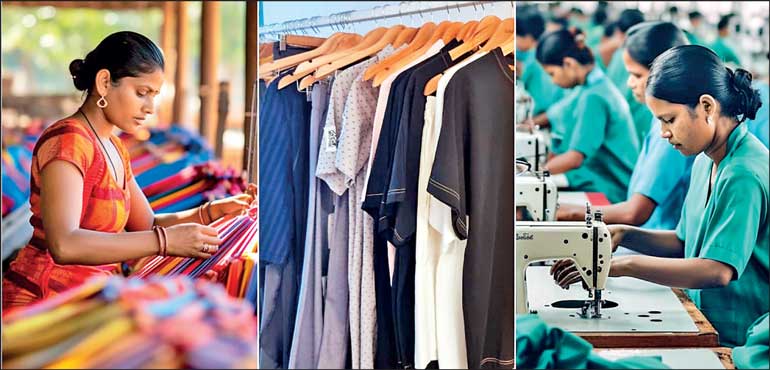Friday Jan 02, 2026
Friday Jan 02, 2026
Saturday, 14 October 2023 02:11 - - {{hitsCtrl.values.hits}}

Considering a changing global landscape and market demand, Sri Lanka’s fashion sector looks at a
transformation towards sustainability and resilience
 The fashion and garment industry is a key contributor to Sri Lanka’s economy, labour market, and export sector. It includes both traditional and contemporary styles and is an important part of the lives and livelihoods of hundreds of thousands of Sri Lankans, while also having a considerable impact on the country’s natural resources, environment, and climate action.
The fashion and garment industry is a key contributor to Sri Lanka’s economy, labour market, and export sector. It includes both traditional and contemporary styles and is an important part of the lives and livelihoods of hundreds of thousands of Sri Lankans, while also having a considerable impact on the country’s natural resources, environment, and climate action.
Considering a changing global landscape and market demand, a transformation of the sector is inevitable. Supply chain transparency and traceability, sustainable raw materials and production methods, reduced environmental footprints, carbon counting, emission reduction, decent work, fair wages, and ethical employment are key areas for the sector’s transition which would ensure that it stays competitive and contributes to green economic growth.
Key concepts for a fashion sector transition
There are several key concepts that connect to this sectoral transformation. For example, the concept of just transition in the fashion industry highlights the importance of leaving no one behind, including small-scale producers, the cottage industry, women, youth, and workers along the fashion supply chains. Through social protection, risk management, worker protections, and partnerships, a just transition can safeguard everyone and ensure a holistic and whole-of-society approach for the shift towards sustainability and resilience.
Other key concepts include circular economy, which describes a cradle-to-grave approach that ensures that waste is minimised and raw materials are used to the optimal extent, including through recycling, upcycling, and production based on offcuts and factory waste; sustainable fashion, which connects to the United Nations’ Sustainable Development Goals (SDGs) and, for example, the targets related to sustainable consumption and production, reduced inequalities, and gender equality; and commitments on climate change that cover both emission reduction and becoming more resilient to climate-related impacts on production and transport.
A resilient and sustainable future for fashion
In a dialogue event hosted on 21 September 2023, Sri Lankan entrepreneurs, designers, and fashion producers outlined several elements that are essential for a resilient and sustainable future of Sri Lanka’s fashion industry.
First of all, this includes the importance of preserving, nurturing, and updating traditional practices, heritage crafts, and artisanal knowledge (such as handloom, batik, or beeralu), especially with regard to building on the local fashion industry and safeguarding existing skills and knowledge for future generations. This goes hand in hand with a wider awareness and understanding of the value of these traditional practices, and how they can link to becoming more sustainable, eco-friendly, and climate-smart.
In addition to knowledge and practices, a skilled labour force and a pool of qualified talent on all levels is necessary to continue the fashion sector’s growth and transition. This could be supported through streamlined recruitment processes, ethical work practices, and fair living wages, as well as enhanced recognition and access to mentorship and support for designers launching their own brands.
The third key point in addition to knowledge and human resources is the need to access sustainably sourced and high-quality raw materials, with both import and domestic production strengthened by a robust monitoring and evaluation system. Finally, several areas for technical support were outlined by entrepreneurs as key enablers for a resilient and sustainable fashion sector, such as support for marketing and brand creation; understanding of available control mechanisms, standards, and certifications; support for prototyping and R&D as well as for ensuring traceability, carbon footprint measurement, and fair trade certifications; and ways to collaborate and exchange, for example, through a central database for fashion sector businesses.
Creating an environment for strengthening these elements in Sri Lanka’s fashion industry is a vital challenge that involves a multitude of actors and stakeholders. By coordinating actions, collecting inputs from all stakeholder groups, and exchanging existing knowledge, multi-actor partnerships can drive transformative change and ensure that the country’s fashion and garment industry stays competitive and can become an engine of green growth on the local, national, and international level.
Looking ahead for sustainable and resilient fashion
Transitioning and transforming Sri Lanka’s fashion industry towards sustainability and resilience is a key task for the mid- and long-term future. The sector has the potential to align with global movements as well as national commitments on climate change, environmental conservation, and sustainable development, and meet evolving customer needs and market demand on the national and international stage.
In addition, enhancing the sector’s resilience against shocks and strengthening risk management will help to safeguard the jobs and livelihoods of hundreds of thousands of individuals across the country, as well as the families and households who depend on them. Embracing sustainability could also unlock new markets and opportunities for Sri Lankan fashion and garment, as eco- and climate-conscious production becomes a competitive advantage on the regional and global level.
(The writer works as Director: Research and Knowledge Management at SLYCAN Trust, a non-profit think tank based in Sri Lanka. His work focuses on climate change, adaptation, resilience, ecosystem conservation, just transition, human mobility, and a range of related issues. He holds a Master’s degree in Education from the University of Cologne, Germany and is a regular writer to several international and local media outlets.)